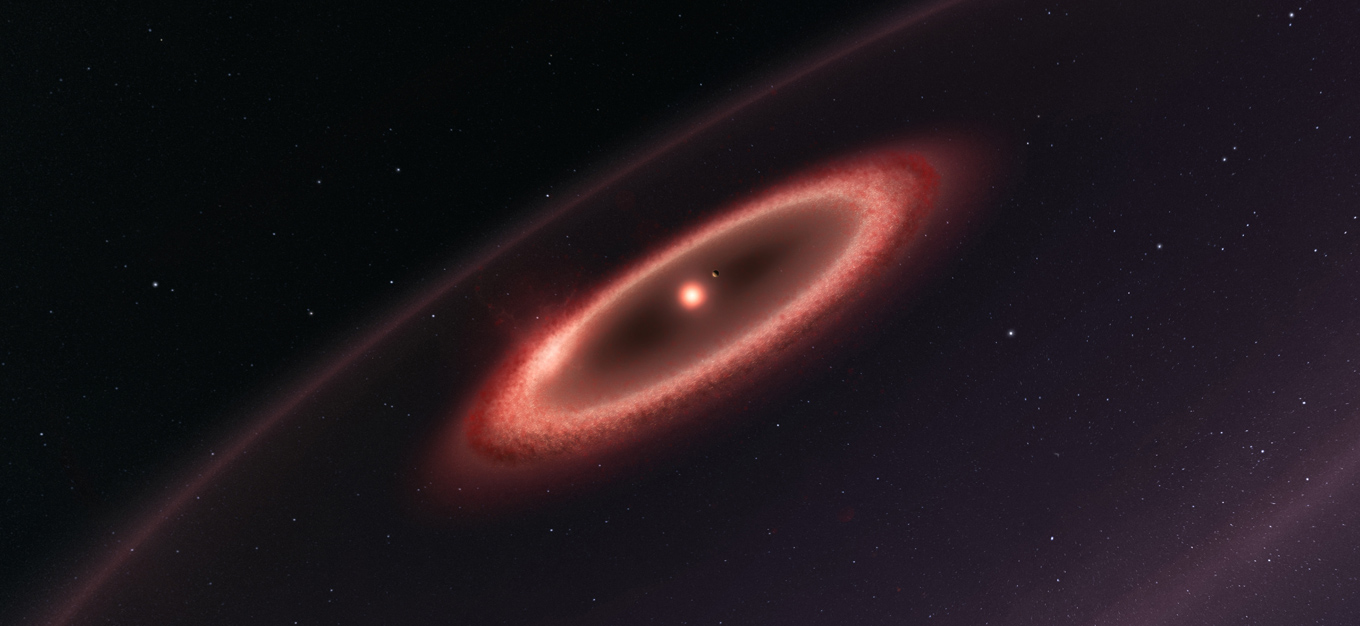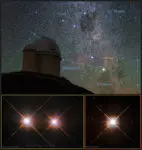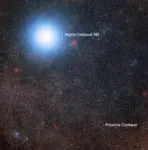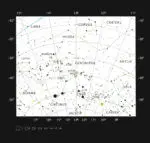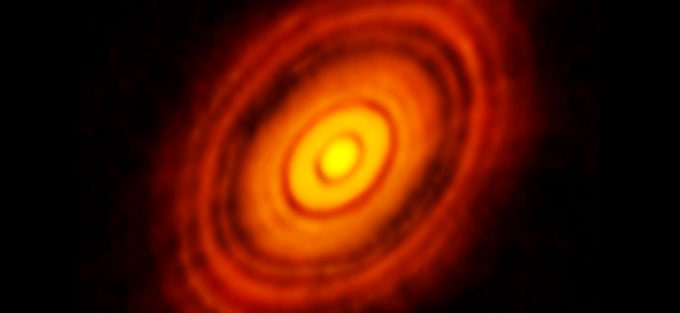ALMA Discovers Cold Dust Around Nearest Star
The ALMA Observatory in Chile has detected dust around the closest star to the Solar System, Proxima Centauri. These new observations reveal the glow coming from cold dust in a region between one to four times as far from Proxima Centauri as the Earth is from the Sun. The data also hint at the presence of an even cooler outer dust belt and may indicate the presence of an elaborate planetary system. These structures are similar to the much larger belts in the Solar System and are also expected to be made from particles of rock and ice that failed to form planets.
Proxima Centauri is the closest star to the Sun. It is a faint red dwarf lying just four light-years away in the southern constellation of Centaurus (The Centaur). It is orbited by the Earth-sized temperate world Proxima b, discovered in 2016 and the closest planet to the Solar System. But there is more to this system than just a single planet. The new ALMA observations reveal emission from clouds of cold cosmic dust surrounding the star.
The lead author of the new study, Guillem Anglada [1], from the Instituto de Astrofísica de Andalucía (CSIC), Granada, Spain, explains the significance of this find: “The dust around Proxima is important because, following the discovery of the terrestrial planet Proxima b, it’s the first indication of the presence of an elaborate planetary system, and not just a single planet, around the star closest to our Sun.”
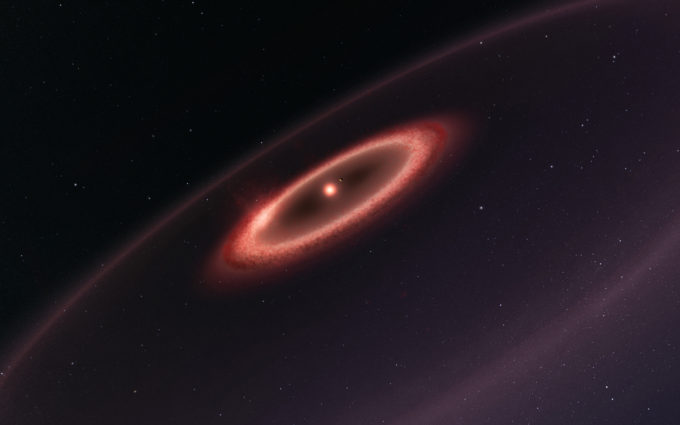
This artist’s impression shows how the newly discovered belts of dust around the closest star to the Solar System, Proxima Centauri, may look. ALMA observations revealed the glow coming from cold dust in a region between one to four times as far from Proxima Centauri as the Earth is from the Sun. The data also hint at the presence of an even cooler outer dust belt and indicate the presence of an elaborate planetary system. These structures are similar to the much larger belts in the Solar System and are also expected to be made from particles of rock and ice that failed to form planets. Note that this sketch is not to scale — to make Proxima b clearly visible it has been shown further from the star and larger than it is in reality. Credit: ESO/M. Kornmesser
Dust belts are the remains of material that did not form into larger bodies such as planets. The particles of rock and ice in these belts vary in size from the tiniest dust grain, smaller than a millimetre across, up to asteroid-like bodies many kilometres in diameter [2].
Dust appears to lie in a belt that extends a few hundred million kilometres from Proxima Centauri and has a total mass of about one hundredth of the Earth’s mass. This belt is estimated to have a temperature of about –230 degrees Celsius, as cold as that of the Kuiper Belt in the outer Solar System.
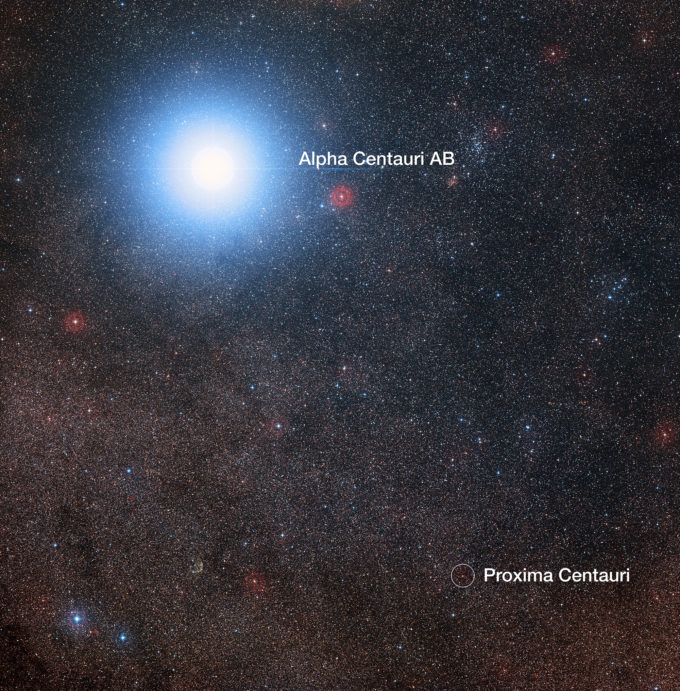
This image of the sky around the bright star Alpha Centauri AB also shows the much fainter red dwarf star, Proxima Centauri, the closest star to the Solar System. The picture was created from pictures forming part of the Digitized Sky Survey 2. The blue halo around Alpha Centauri AB is an artifact of the photographic process, the star is really pale yellow in colour like the Sun. Credit:
Digitized Sky Survey 2 | Acknowledgement: Davide De Martin/Mahdi Zamani
There are also hints in the ALMA data of another belt of even colder dust about ten times further out. If confirmed, the nature of an outer belt is intriguing, given its very cold environment far from a star that is cooler and fainter than the Sun. Both belts are much further from Proxima Centauri than the planet Proxima b, which orbits at just four million kilometres from its parent star [3].
Guillem Anglada explains the implications of the discovery: “This result suggests that Proxima Centauri may have a multiple planet system with a rich history of interactions that resulted in the formation of a dust belt. Further study may also provide information that might point to the locations of as yet unidentified additional planets.”
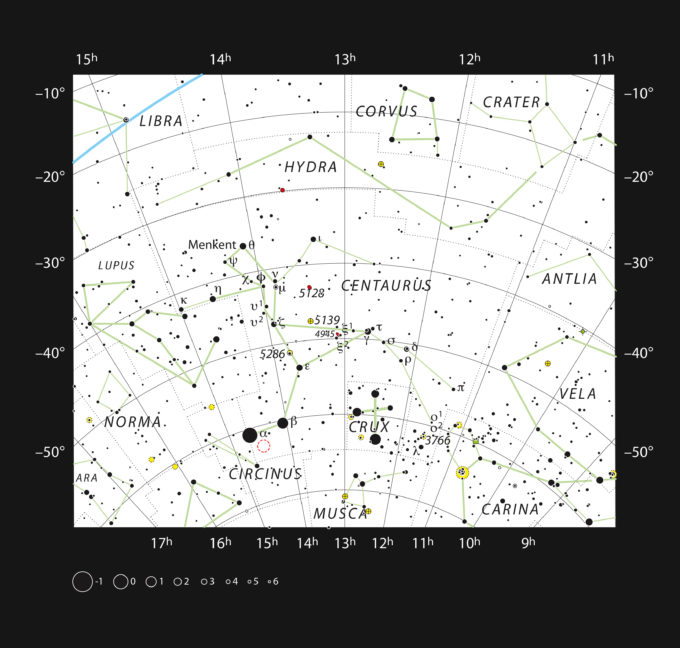
This chart shows the large southern constellation of Centaurus (The Centaur) and shows most of the stars visible with the naked eye on a clear dark night. The location of the closest star to the Solar System, Proxima Centauri, is marked with a red circle. Proxima is too faint to see with the unaided eye but can be found using a small telescope. Credit: ESO/IAU and Sky & Telescope
Proxima Centauri's planetary system is also particularly interesting because there are plans — the Starshot project — for future direct exploration of the system with microprobes attached to laser-driven sails. A knowledge of the dust environment around the star is essential for planning such a mission.
Co-author Pedro Amado, also from the Instituto de Astrofísica de Andalucía, explains that this observation is just the start: “These first results show that ALMA can detect dust structures orbiting around Proxima. Further observations will give us a more detailed picture of Proxima's planetary system. In combination with the study of protoplanetary discs around young stars, many of the details of the processes that led to the formation of the Earth and the Solar System about 4600 million years ago will be unveiled. What we are seeing now is just the appetiser compared to what is coming!”
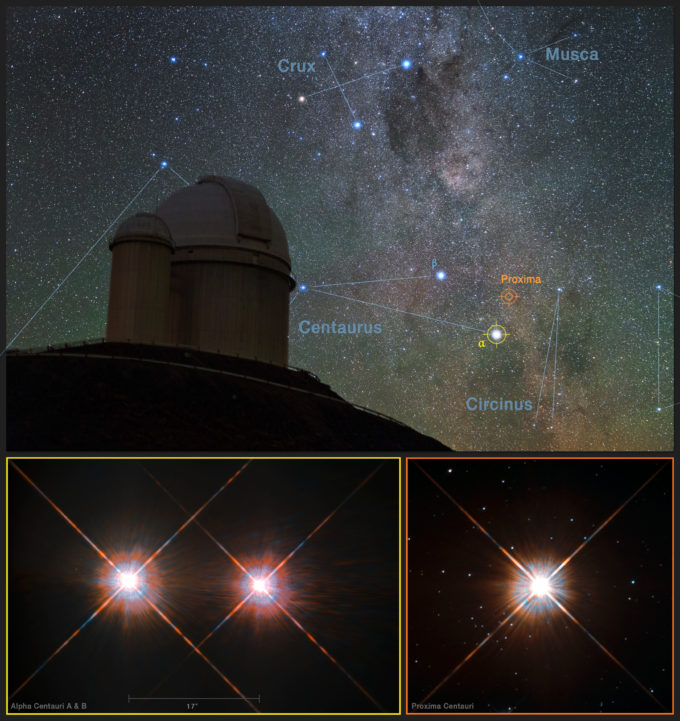
This picture combines a view of the southern skies over the ESO 3.6-metre telescope at the La Silla Observatory in Chile with images of the stars Proxima Centauri (lower-right) and the double star Alpha Centauri AB (lower-left) from the NASA/ESA Hubble Space Telescope. Proxima Centauri is the closest star to the Solar System and is orbited by the planet Proxima b, which was discovered using the HARPS instrument on the ESO 3.6-metre telescope. Credit: Y. Beletsky (LCO)/ESO/ESA/NASA/M. Zamani
Notes
[1] In a cosmic coincidence, the lead author of the study, Guillem Anglada shares his name with the astronomer who led the team that discovered Proxima Centauri b, Guillem Anglada-Escudé, himself a co-author of the paper in which this research is published, although the two are not related.
[2] Proxima Centauri is quite an old star, of similar age to the Solar System. The dusty belts around it are probably similar to the residual dust in the Kuiper Belt and the asteroid belt in the Solar System and the dust that creates the Zodiacal Light. The spectacular discs that ALMA has imaged around much younger stars, such as HL Tauri, contain much more material that is in the process of forming planets.
[3] The apparent shape of the very faint outer belt, if confirmed, would give astronomers a way to estimate the inclination of the Proxima Centauri planetary system. It would appear elliptical due to the tilt of what is assumed to be in reality a circular ring. This would in turn allow a better determination of the mass of the Proxima b planet, which is currently known only as a lower limit.
Additional information
This research was presented in a paper entitled “ALMA Discovery of Dust Belts Around Proxima Centauri”, by Guillem Anglada et al., to appear in Astrophysical Journal Letters.
The team is composed of Guillem Anglada (Instituto de Astrofísica de Andalucía (CSIC), Granada, Spain [IAA-CSIC]), Pedro J. Amado (IAA-CSIC), Jose L. Ortiz (IAA-CSIC), José F. Gómez (IAA-CSIC), Enrique Macías (Boston University, Massachusetts, USA), Antxon Alberdi (IAA-CSIC), Mayra Osorio (IAA-CSIC), José L. Gómez (IAA-CSIC), Itziar de Gregorio-Monsalvo (ESO, Santiago, Chile; Joint ALMA Observatory, Santiago, Chile), Miguel A. Pérez-Torres (IAA-CSIC; Universidad de Zaragoza, Zaragoza, Spain), Guillem Anglada-Escudé (Queen Mary University of London, London, United Kingdom), Zaira M. Berdiñas (Universidad de Chile, Santiago, Chile; IAA-CSIC), James S. Jenkins (Universidad de Chile, Santiago, Chile), Izaskun Jimenez-Serra (Queen Mary University of London, London, United Kingdom), Luisa M. Lara (IAA-CSIC), Maria J. López-González (IAA-CSIC), Manuel López-Puertas (IAA-CSIC), Nicolas Morales (IAA-CSIC), Ignasi Ribas (Institut de Ciències de l’Espai (IEEC-CSIC), Bellaterra, Spain), Anita M. S. Richards (JBCA, University of Manchester, Manchester, United Kingdom), Cristina Rodríguez-López (IAA-CSIC) and Eloy Rodríguez (IAA-CSIC).
The Atacama Large Millimeter/submillimeter Array (ALMA), an international astronomy facility, is a partnership of the European Organisation for Astronomical Research in the Southern Hemisphere (ESO), the U.S. National Science Foundation (NSF) and the National Institutes of Natural Sciences (NINS) of Japan in cooperation with the Republic of Chile. ALMA is funded by ESO on behalf of its Member States, by NSF in cooperation with the National Research Council of Canada (NRC) and the Ministry of Science and Technology (MOST) in Taiwan and by NINS in cooperation with the Academia Sinica (AS) in Taiwan and the Korea Astronomy and Space Science Institute (KASI).
ALMA construction and operations are led by ESO on behalf of its Member States; by the National Radio Astronomy Observatory (NRAO), managed by Associated Universities, Inc. (AUI), on behalf of North America; and by the National Astronomical Observatory of Japan (NAOJ) on behalf of East Asia. The Joint ALMA Observatory (JAO) provides the unified leadership and management of the construction, commissioning and operation of ALMA.
Links
Contacts
-
Guillem Anglada
Instituto de Astrofísica de Andalucía (CSIC)Granada, SpainEmail: [email protected] -
Pedro J. Amado
Instituto de Astrofísica de Andalucía (CSIC)Granada, SpainEmail: [email protected] -
Antxon Alberdi
Instituto de Astrofísica de Andalucía (CSIC)Granada, SpainEmail: [email protected] -
Enrique Macias
Boston UniversityBoston, USAEmail: [email protected] -
Richard Hook
Public Information Officer, ESOGarching bei München, GermanyPhone: +49 89 3200 6655Cel: +49 151 1537 3591Email: [email protected] -
Charles E. Blue
Public Information OfficerNational Radio Astronomy Observatory Charlottesville, Virginia - USAPhone: +1 434 296 0314Cel: +1 202 236 6324Email: [email protected] -
Masaaki Hiramatsu
Education and Public Outreach Officer, NAOJ Chile
